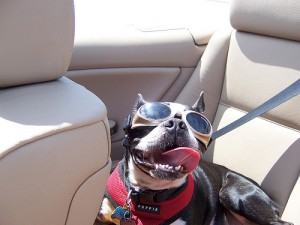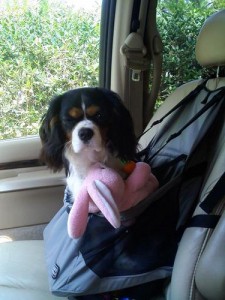 You’ve seen the ads: Dogs riding in convertibles, wind in their fur, free….
You’ve seen the ads: Dogs riding in convertibles, wind in their fur, free….
…to become projectiles.
The safety benefits of car restraints for humans are no longer in dispute: 49 of 50 U.S. states have seat belt laws, and the same number of states require additional restraints for children — for example, rear-facing infant seats or child booster seats.
Yet people who wouldn’t dream of driving their kids around without buckling them in have a blind spot when it comes to their dogs. Harnesses? Crates? Booster seats? No way. “I don’t want to restrict my dog’s freedom,” these owners protest. Of them I ask, “Would you want your pup to enjoy the freedom of going through the windshield?”
For a safe ride with your pup, observe these basics:

#1: Dogs should always travel inside the vehicle
This might seem like a no-brainer but it bears repeating: it’s very dangerous to let a dog ride in the open bed of a pickup truck. Approximately 100,000 dogs die every year from falling or jumping out of pickups and countless more are injured.
#2. Driving with an unrestrained dog in your car is not only dangerous, but potentially expensive — and publicly humiliating.
Untethered dogs pose not only safety issues but legal and economic ones. Many states have passed variations of the law in Washington, where it’s a misdemeanor to “willfully transport or confine…any domestic animal… in a manner, posture or confinement that will jeopardize the safety of the animal or the public.” (Some laws specify that this includes having a dog in the back of a pickup truck.) Accordingly, if your unsecured dog causes an accident, your insurance is rendered invalid under many policies. And even if the accident is the other driver’s fault, your vet bills won’t be paid if your dog wasn’t properly restrained.
And then there’s the potential for unwelcome notoriety. You never know who you’ll hit if your dog distracts you to the point of causing an accident. Case in point: While walking along the side of the road in 1999, author Stephen King was struck by a minivan. Driver Bryan Smith claimed he had been distracted by his Rottweiler, Bullet, who was rooting around in the vehicle, trying to raid the food cooler. Smith, who died the following year of a drug overdose ruled accidental, subsequently turned up as a character in King’s Dark Tower series.
#3. Choose your restraints carefully
You’ll achieve the best dog security with a harness — never, ever, a collar — hooked to the car’s back seat belt. A regular harness will work in a pinch — pinch being the operative word — but the ones designed especially for travel have padding that insulates your dog against pressure caused by a sudden stop. The top models also have hooking mechanisms that let your dog move, though not too much, and are easy to click open and shut. See the “Product Reviews” section of AgilePooch.com for a travel halter comparison.

If your dog weighs less than 20 pounds, consider a booster seat, similar to the kiddie version. Not only is it a good restraint device, but a pup that can gaze out the window is less likely to get bored or carsick.
For more bloggers participating in the second annual Pet ‘Net Safety event, see www.petside.com/pet-net-2009

Pet ‘seat belts’ are all well and good — but why not use the best protection you can offer your dogs, a hard-sided crate properly secured in the back seat of the vehicle? Even in a harness or booster seat, a pet is exposed. In a solid-sided plastic, wood or metal crate, the dog is protected from flying glass and other shrapnel as well as being more secure if your vehicle is hit.
Thanks for mentioning crates in more detail. The reason I didn’t mention them in more than passing was because most people find it too much of a hassle to put a dog in a crate for a short trip. For long car trips it can be a great option, but not for every dog. Some dogs get carsick if they can’t look out the window. And in case of a collision, a dog could be flung against the side of a crate and be injured too. So there’s no perfect solution, but for me a dog can get more enjoyment out of a ride by being belted than by being crated. And people are less resistant to the idea.
I’m with Pat. Crates are the best way to go. Though, while working on an article on car safety for AKC recently, I interviewed someone who uses a harness, seat extenders, and a hammock-style seat blanket to great effect.
Thanks for your input. I’m getting won over. So tell me… do people just leave the crate strapped into the car, making it a viable option for quick trips? And do you make an exception for dogs that get carsick or do you find that it’s not a significant issue?
Edie, it’s a standing joke at the local dog obedience club that *some* of us have a crate addiction — I currently own 2 dogs, 1 cat, and over 20 crates. I have two #200 airline crates in the cargo area of my Jeep Patriot 24/7. They only come out when I need to move something that requires the entire back end of my vehicle. Under them are four soft crates in assorted sizes. Between the plastic “riding” crates and the passenger seat is a folded soft (fabric) 36″ ex-pen. The only item I own more of than crates are bungee cords; when you travel with dogs, bungee cords are your friends.
My crates are securely strapped to the tie-downs cleats embedded in the sides and floor of the Patriot’s cargo deck. Two overlapping bungees cross the top of the crates. This secures the crates both to the vehicle and to each other. Since bungees are flexibe, I can quickly remove a couple cords to free a crate and remove it from the car when necessary. When Churro the cat joins the entourage (yes, he goes to dog shows and camping), I fold down a section of the split rear seat and bungee his crate to those tie-down cleats. Easy in, easy out.
A Patriot is a small station wagon. Yes, it’s easier to do this with crates in vehicles with a cargo area. But I’ve also secured crates to the rear seat in conventional two and four-door sedans. When M. came home to live with me, I picked her up at the Harrisburg KC show in a rented two-door Ford Focus. I bought a crate at the show and picked up more bungee cords at a local 99-cent store. Between the bungees and the seat-belts in the rear seat, I could safely secure the crate for the short trip from show site to motel, and for the three-hour trip home.
I crate dogs whether I’m driving a mile down the road or eight hours. My crates stay in the car 99% of the time. Yes, I choose my vehicles based on whether the crates fit (no two-seater sports cars for me…) But just as two-seater sports cars aren’t the best driving choice for a family with kids, having a car with room for crate(s) is the best driving choice for a family with a dog. Even a single person with a two-seater can put a crate in the car (as long as his dog isn’t a Mastiff – now we’re back to choosing an appropriate dog-car…) It’s just as important as having seat belt for me or a booster seat for a child.
I have had clients who insisted that keeping a crate in the car would take up too much space. One of them had a Yorkie and needed, at most, a cat-sized #100 crate. Groceries take up more room than that! I ask what they’d do if they had to carry a booster seat for a child for five years, and after they consider that, I show them how to safely secure a crate in a way that let’s them get it in and out of the car in a hurry.
Some folks’ dogs need a crate that won’t fit in their vehicles — and I can see why you might not want to own an SUV just because you have an Irish Wolfhound. I usually recommend barriers between the driver’s seat compartment and the rear of the vehicle to those clients. That’s not my favorite solution. But it’s far safer than a harness, IMO, for a dog that size.
Dogs do get car sick. One of my own had what my mom used to call a ‘glass stomach.’ Traveling on an empty stomach, giving her a teaspoon of honey before we left, keeping fresh air circulating in a cool vehicle and keeping her crate as stable as possible on the front passenger seat helped. Driving better (no sudden stops, jack rabbit starts or twisting roads with a lot of speed up-down) helped, too.
Putting Muni in the car and not going anywhere prevented any anxiety about car trips. Feeding her in her crate in the car meant that it was a safe place to be. Short rides to places she liked reinforced that the car was a fun place. Most of the time, my efforts to control her motion-sickness paid off. So while she occasionally had an upset stomach on the road, she happily made road trips all of her life. I work with owners of motion-sick dogs to find out what tricks will ease their experiences. Sometimes, nothing but motion sickness meds will help – but most dogs can be made comfortable. And no dog *has* to ride in the car unless it’s to the vet or to move across the country, so bottom-line, if even motion-sickness meds don’t help, the owner might have to deal with leaving Spot home.
Just one more thing – a car-sick dog isn’t necessarily going to be helped by looking out the window. I experience motion sickness, too, but looking out a window usually makes it worse. It’s the cool air and ventilation that helps alleviate motion sickness, and that will help the dog even if s/he’s crated.
Thanks so much for elaborating, Pat. Here, hidden in the comments section, I’m going to admit that, except when I needed to keep him from re-injuring his back and then it was in a large enclosure, I never crate Frankie. That’s doubtless the reason that I focused on seat-belt harnesses. Not crating is something I plan to blog about — when I get up the nerve (and some additional support for my views in theoretical, not emotional, terms).
Glad to see you are raising awareness about the number of dogs killed by falling out of pick-up trucks! This is just a huge, huge problem, in the Southwest especially.
here’s an idea, for all you Detroit sales teams reading this blog: I wonder if maybe a pick-up manufacturer would get on the bandwagon with an accessory harness or pick-up crate you could order when you buy the Chevy pick-up and are adding those retro hubcaps….certainly something different they can tout..
By the way, you write “approximately 100,000 dogs” are killed or injured each year – I’d like to re-quote that at some point in a blog – is there a primary source for this or is this a (valid) generalization?
Thanks, Diane.
That’s an interesting question about the statistic. I found the source — at least what I think is the source — second hand from a right wing site under what the blogger called “Stupid Statistics” (at least I’m assuming it’s a right wing site because all the blogger’s comments seem aimed at pointing out how misguided liberals are):
***
One hundred thousand dogs are killed each year falling out of pickup trucks.
No, wait . . . this is my favorite stupid statistic, again from Parade. Think about it — that’s 274 dogs a day, 11 dogs a hour, falling out of trucks. Two thousand dogs a year per state. Have you ever seen or heard of a dog dying this way? Of course, the data was from the Humane Society, campaigning for the banning of pickup trucks, or something . . .
***
So I’m thinking the original source was Parade magazine, quoting the Humane Society, but I can’t find any stats on the Humane Society’s site.
As it happens, I personally know two greyhounds that were injured because they were in the back of a pickup that got rear ended. It was a covered pickup, but the cover popped off with the collision and the greyhounds escaped into traffic and were hit. So hell yes, I believe it happens all the time.
Right. well, who’s to say the right wing is not good for someting. to add to that topic, not to be morbid of course but, all you have to do is count the otherwise healthy dogs lying along the highway in the middle of nowhere as you drive along 1-40 from Albquerque to Flagstaff to know they didn’t just drop out of the sky there.
Of course people riding in the back of pick-up trucks and kids on school buses should also have safety harnesses, and maybe auto makers should be selling child booster seats too, but dogs aren’t given a choice. I couldn’t believe the opening lines of a story in the New Yorker recently comparing football injuries with those suffered by dogs in arranged dogfights. Okay, they both get lousy injuries, but to at least some greater degree than the dogs, the football players had some choice of profession.
Well, you’ve convinced me. I’m going out to buy a crate for my grandson on our next trip to Circle K. Why should he be less safe than a dog? And god knows he’s cute enough to distract the driver from his car seat.
Hmmm. I think there are laws against that, although I supposed child car seat laws don’t say that the seats have to be open, as long as there’s air…
Interesting debate there, and all I’m going to add is that some car harnesses are far safer than others, as very, very few have been tested, let alone crash tested.
There are 2 types that have been tested. Pet Buckle spent millions of dollars crash testing theirs and they are a bestseller but unfortunately are not available in enough sizes.
The other type of rigorous test that can be done by manufacturers is the strength test below and this is has been successfully achieved by Bergan whose car harnesses come in a full range of sizes to fit dogs from 10-80 llbs+.
meet V9DT B2009.1. Pet Safety Durability Test (see http://www.v9dt.com)
Unfortunately many people are also attaching universal dog seat belt straps to regular walking harnesses which are not designed to be used as a car safety harness and hence may give way if the worst happens.
I am of the opinion that manufacturers should have to state their car harnesses are untested if they are not, as the public in general would not necessarily be aware of test regulations.
Crates seem far more popular in the US, I remain neutral on them, as I would still worry about a dog getting thrown around in the crate.